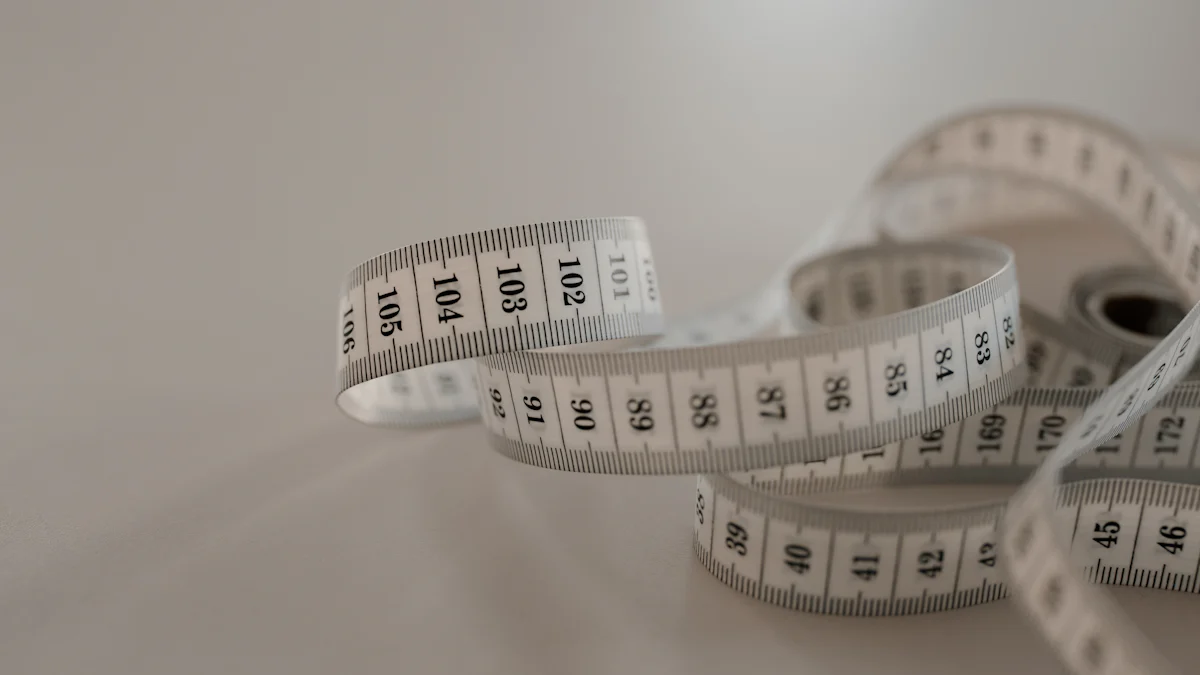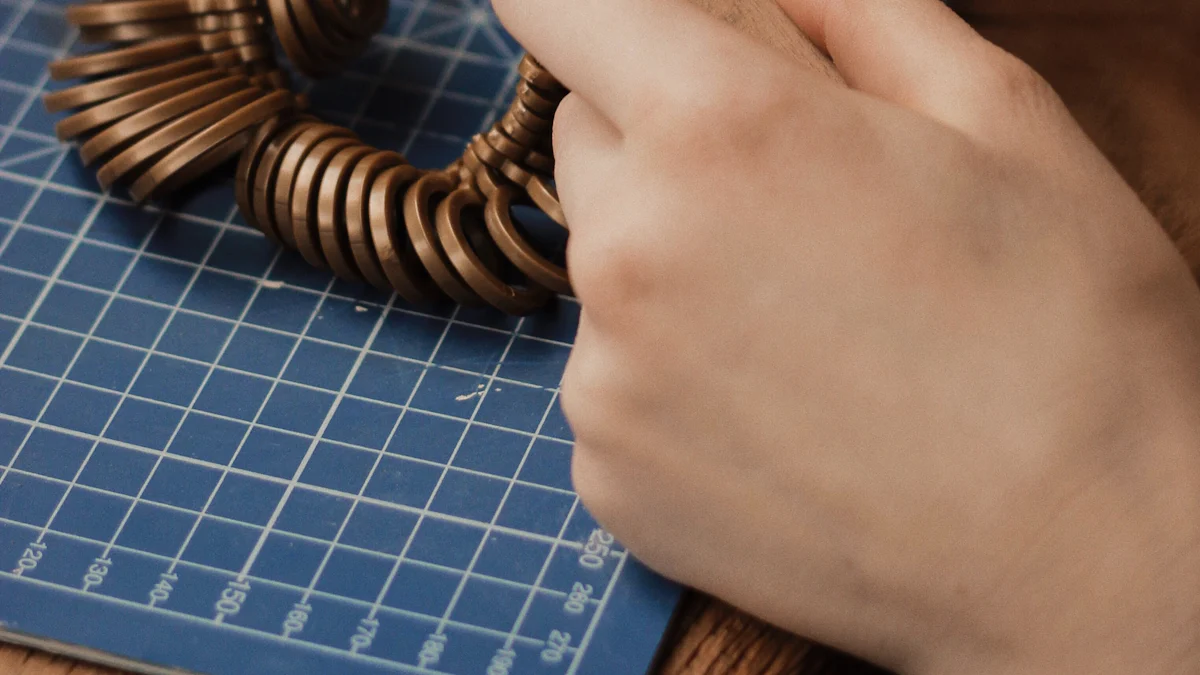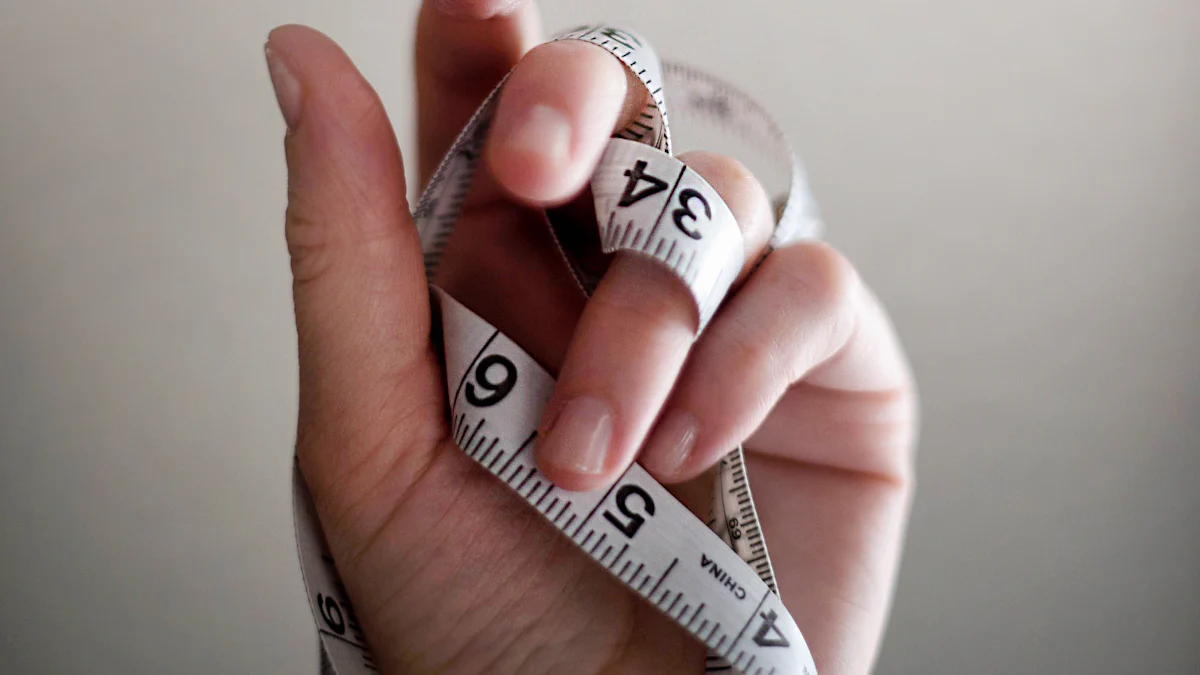Avoid Errors with These Ring Measurement Tips

Getting the right ring size matters more than you might think. A poorly sized ring can lead to discomfort, constant adjustments, or even the hassle of resizing. Imagine ordering a beautiful ring online, only to find it doesn’t fit. That’s frustrating, right? Accurate ring measurement saves you from these headaches. It ensures a perfect fit and keeps your investment worthwhile. Professional jewelers emphasize the importance of precision, as their tools and expertise guarantee reliable results. Whether you’re measuring at home or consulting an expert, taking the time to get it right makes all the difference.
Common Mistakes to Avoid in Ring Measurement

Measuring at the Wrong Time
Timing plays a crucial role in getting accurate ring measurements. Your fingers don’t stay the same size throughout the day. They can swell in the heat or shrink when it’s cold. Measuring at the wrong time of day, like early in the morning or after a workout, often leads to errors. For example, if you measure your finger when it’s swollen, the ring might feel loose later when your hands cool down.
One person shared their experience of trying on a ring during a swollen state. It fit perfectly at the time, but later, when their hands cooled, the ring slid off too easily. This highlights why you should measure your finger when it’s at a normal temperature. Aim for midday or evening when your hands are neither too warm nor too cold. This ensures a more reliable fit.
Using Improper Tools for Measuring Ring Size
Using the wrong measuring tool is another common mistake when measuring ring size. A flexible measuring tape or a piece of string might seem convenient, but they can stretch or slip, leading to inaccurate results. Instead, opt for a proper ring sizing tool, like an adjustable ring belt or an online ring sizer. These tools are designed to provide precise measurements.
Professional jewelers use calibrated tools for a reason—they eliminate guesswork. If you’re measuring at home, invest in a reliable ring sizing tool. It’s a small step that saves you from the hassle of resizing later. Remember, accuracy starts with the right tools.
Ignoring Environmental Factors
Neglecting temperature variations and other environmental factors can throw off your measurements. Cold weather causes your fingers to shrink, while heat or humidity makes them swell. If you measure your finger in extreme conditions, the size won’t reflect how the ring will fit in everyday situations.
Another individual shared how their engagement ring felt loose during chilly weather and almost slipped off into the garbage. This shows why you should avoid overcompensating for swelling or ignoring seasonal changes. Consider the climate and your daily activities when measuring. A snug fit in all conditions is the goal.
By avoiding these common mistakes when measuring, you’ll save yourself from frustration and ensure a perfect fit every time.
Overlooking Ring Style and Fit
The style and design of a ring can significantly impact how it fits on your finger. Many people focus solely on the size, forgetting that the width and shape of the ring also play a crucial role. For instance, wider bands tend to feel tighter compared to thinner ones, even if they share the same size. If you’re considering a ring with a wide band, you might need to size up slightly for a comfortable fit.
Certain ring styles, like those with large gemstones or intricate details, can also affect how the ring sits on your finger. A bulky setting may cause the ring to tilt or feel uneven, especially if the size isn’t perfect. Trying on rings with similar designs can help you get a better idea of what works best for your finger. This step ensures that the ring not only fits but also feels balanced and secure.
Guessing your size without considering the ring’s style is one of the most common mistakes people make. This often leads to rings that are either too tight or too loose, causing discomfort or making the ring prone to slipping off. Always take the time to factor in the design and width when measuring your size. A ring that fits well should feel snug but not restrictive, regardless of its style.
If you’re unsure about how a specific design might affect the fit, consult a professional jeweler. They can guide you in choosing the right size based on the ring’s style and your preferences. Remember, a well-fitted ring isn’t just about size—it’s about comfort and wearability in every situation.
Tips for Accurate Ring Sizing

Use Reliable Tools for Ring Measurement
Using the right tools makes all the difference when it comes to measuring ring size. A ring sizing tool, like a plastic finger gauge or a ring mandrel, ensures you get an accurate measurement. These tools are specifically designed for this purpose and eliminate the guesswork that often comes with DIY methods. For example, a ring sizer set includes rings in various sizes that you can try on to find the perfect fit. This method is simple, precise, and widely recommended.
If you’re measuring at home, investing in a reliable measuring tool is worth it. Many affordable options are available online, such as adjustable ring belts or pop-out ring sizers. These tools provide consistent results and help you avoid the inaccuracies of using string or paper. Jewelers also rely on calibrated tools like metal mandrels to ensure precision. Whether you’re shopping for yourself or someone else, using the right tools guarantees a better fit.
Measure Multiple Times for Consistency
Taking multiple measurements is one of the most effective tips for ensuring accurate ring sizing. Your fingers can change size throughout the day due to factors like temperature or activity. Measuring just once might not give you the most reliable result. Instead, measure your finger at different times—morning, afternoon, and evening. This approach helps you account for any fluctuations and find an average size that feels comfortable.
When you measure multiple times, use the same sizer or tool for consistency. Avoid switching between methods, as this can lead to discrepancies. For instance, if you start with a plastic ring gauge, stick with it for all your measurements. This practice minimizes errors and ensures your final size is accurate. Remember, a little extra effort now saves you from resizing hassles later.
Consider Environmental and Personal Factors
Environmental and personal factors play a significant role in achieving accurate measurements. Temperature, for instance, affects your finger size. Cold weather causes your fingers to shrink, while heat or humidity makes them swell. To get the best results, measure your finger when it’s at a normal temperature. Avoid measuring right after exercising or during extreme weather conditions.
Personal factors, like the shape of your knuckle, also matter. If your knuckle is larger than the base of your finger, choose a size that slides over the knuckle comfortably but doesn’t feel too loose. Additionally, consider how the ring will fit during daily activities. A snug but comfortable fit ensures the ring stays secure without causing discomfort.
By keeping these tips in mind, you’ll achieve accurate ring sizing that works for every situation. Whether you’re using a ring sizer or consulting a jeweler, these steps guide you toward the perfect fit.
Account for Ring Style and Design
The style and design of a ring can greatly influence how it fits on your finger. You might think that size is the only factor, but the width, shape, and even the interior design of the ring play a big role in comfort and wearability. Let’s break it down so you can make the best choice.
First, consider the width of the ring. Wider bands tend to feel tighter compared to thinner ones, even if they’re technically the same size. If you’re choosing a ring with a wide band, it’s a good idea to size up slightly. This ensures the ring doesn’t feel restrictive when worn for long periods. On the other hand, slim bands often fit more loosely, so sticking to your exact size usually works well.
Next, think about the design details. Rings with large gemstones or intricate patterns can affect how the ring sits on your finger. For example, a top-heavy design might cause the ring to tilt or spin if the sizing isn’t just right. If you’re drawn to bold or elaborate styles, make sure the ring fits snugly enough to stay balanced but not so tight that it becomes uncomfortable.
The interior shape of the ring also matters. Standard fit rings have a flat interior, while comfort fit rings feature a slightly curved interior. The curved design of comfort fit rings makes them easier to slide on and off, especially for wider bands. If you’re unsure which to choose, try both styles to see which feels better on your finger.
For those with bony fingers, finding the right fit can be tricky. Rings often need to fit snugly at the base of the finger to prevent slipping, especially if the knuckle is larger than the finger’s base. Slim bands or rings with heavy tops may require extra attention during sizing to ensure they stay secure.
Here are some quick tips to keep in mind when considering ring style and design:
- Try on similar styles: If possible, test rings with similar widths or designs to get a feel for how they fit.
- Consult a jeweler: A professional can guide you in adjusting the size based on the ring’s style and your preferences.
- Think about daily wear: Choose a design that feels comfortable and stays in place during your usual activities.
By accounting for these factors, you’ll ensure your ring not only fits well but also feels great to wear. Remember, proper ring sizing isn’t just about numbers—it’s about finding the perfect balance between style and comfort.
Special Considerations for Measuring Ring Size
Measuring Ring Size Discreetly for Someone Else
Planning a surprise proposal or gift? Measuring ring size discreetly can feel tricky, but it’s not impossible. You just need a little creativity and the right approach. Start by borrowing a ring they already wear on the intended finger. Use a reliable ring sizing tool to measure it. If you don’t have one, take the ring to a jeweler for precise measurements. They’ll help you determine the exact size without raising suspicion.
If borrowing a ring isn’t an option, enlist the help of someone close to them. A friend or family member might know their size or could casually ask without giving away the surprise. Another clever trick is to trace the inside of their ring on paper. This outline can guide a jeweler in estimating the size.
When all else fails, guess slightly larger rather than smaller. It’s easier to resize a ring that’s too big than one that’s too small. For the most accurate results, consider consulting a professional jeweler. As Michelle from Berlinger Jewelry shared, “Personalized assistance ensures a perfect fit for that special moment.” Their expertise can make all the difference in pulling off your surprise flawlessly.
Adjusting for International Ring Sizing Standards
If you’re buying a ring internationally, understanding different sizing standards is essential. Countries use varying systems, which can lead to confusion if you’re not prepared. For example, the United States uses numerical sizes, while many European countries rely on circumference measurements in millimeters. Knowing how to convert between these systems ensures you get the right fit.
Start by identifying the sizing system used in the country where you’re purchasing the ring. Many online charts can help you convert sizes accurately. If you’re unsure, consult a jeweler. They can guide you through the process and ensure your measurements align with the international standard.
When shopping online, check if the retailer provides a conversion chart. Some websites even offer printable ring sizers to help you measure at home. Using these tools minimizes the risk of errors. If possible, opt for retailers that allow resizing or exchanges. This flexibility gives you peace of mind in case the size isn’t perfect.
Professional jewelers also recommend using a calibrated ring sizing tool when dealing with international sizes. These tools provide precise results and eliminate guesswork. As one expert noted, “Visiting a local jeweler for professional ring sizing is highly recommended.” Their guidance ensures your ring fits perfectly, no matter where it’s from.
By considering these factors, you’ll navigate international sizing standards with ease. Whether you’re surprising someone or shopping for yourself, taking the time to understand these differences guarantees a comfortable and secure fit.
Getting the right fit for your ring starts with avoiding common mistakes and using the proper tools. Accurate ring measurement ensures comfort and prevents unnecessary resizing. By considering environmental factors like temperature and the impact of ring style, you can achieve a fit that feels just right. Don’t hesitate to seek professional sizing if you’re unsure. Jewelers have the expertise and tools to guide you. With these tips, you’ll save time, avoid frustration, and enjoy a ring that fits perfectly every time.
FAQ
Why is determining ring size accurately at home important?
Getting your ring size right at home saves you from the hassle of resizing or returning a ring. A poorly sized ring can feel uncomfortable or even slip off. By measuring accurately, you ensure the ring fits perfectly and stays secure. Plus, it makes online shopping easier and more reliable.
What tools should I use to measure my ring size?
Using proper tools ensures accurate results. A ring sizer or an adjustable ring belt works best. These tools are designed specifically for measuring ring sizes. Avoid using string or paper, as they can stretch or slip, leading to errors. If you don’t have access to these tools, visiting a jeweler is always a great option.
Can I measure my ring size at any time of the day?
No, timing matters. Your fingers change size throughout the day due to temperature and activity. Measure your finger when it’s at a normal temperature, ideally in the afternoon or evening. Avoid measuring early in the morning or after exercising, as these times can lead to inaccurate results.
How do environmental factors affect ring sizing?
Environmental factors like temperature and humidity can impact your finger size. Cold weather causes your fingers to shrink, while heat makes them swell. To get the most accurate measurement, measure your finger in a comfortable, room-temperature environment.
What should I do if my knuckle is larger than the base of my finger?
If your knuckle is larger, choose a size that slides over the knuckle comfortably but doesn’t feel too loose at the base. A snug fit ensures the ring stays secure without causing discomfort. Comfort-fit rings with a curved interior can also help in this situation.
How does ring style influence sizing?
The width and design of a ring can affect how it fits. Wider bands feel tighter, so you might need to size up slightly. Rings with large gemstones or intricate details may require a snugger fit to stay balanced. Always consider the ring’s style when determining your size.
Can I measure someone else’s ring size without them knowing?
Yes, you can measure discreetly. Borrow a ring they wear on the intended finger and use a ring sizer to determine the size. If borrowing isn’t possible, enlist the help of a close friend or family member. Tracing the inside of their ring on paper is another clever trick.
What should I know about international ring sizing?
Different countries use different sizing systems. For example, the U.S. uses numerical sizes, while Europe measures in millimeters. Use an online conversion chart or consult a jeweler to ensure accuracy when buying internationally. Some retailers also offer resizing options for added convenience.
Is it better to size up or down if I’m unsure?
If you’re unsure, it’s safer to size up. A ring that’s slightly too big can be resized more easily than one that’s too small. A professional jeweler can adjust the size to ensure a perfect fit.
Should I consult a jeweler for ring sizing?
Absolutely! Jewelers have the tools and expertise to provide precise measurements. If you’re unsure about measuring at home or dealing with unique factors like wide bands or large knuckles, a jeweler’s guidance can make all the difference.
See Also
Tips for Selecting the Perfect Finger for Your Ring
All-in-One Guide for Engagement and Wedding Ring Selection
Proper Ways to Wear Your Engagement and Wedding Rings

